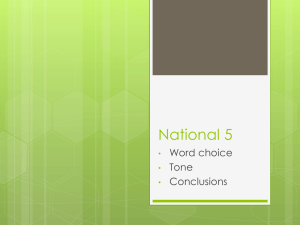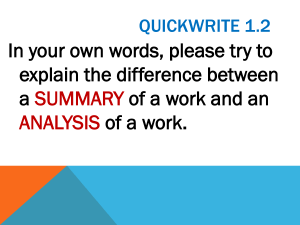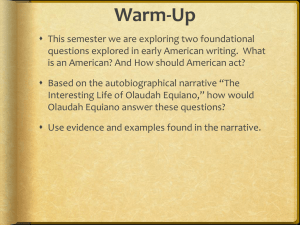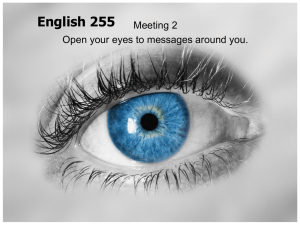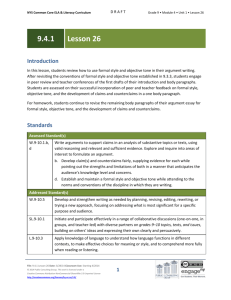argumentation PowerPoint
advertisement
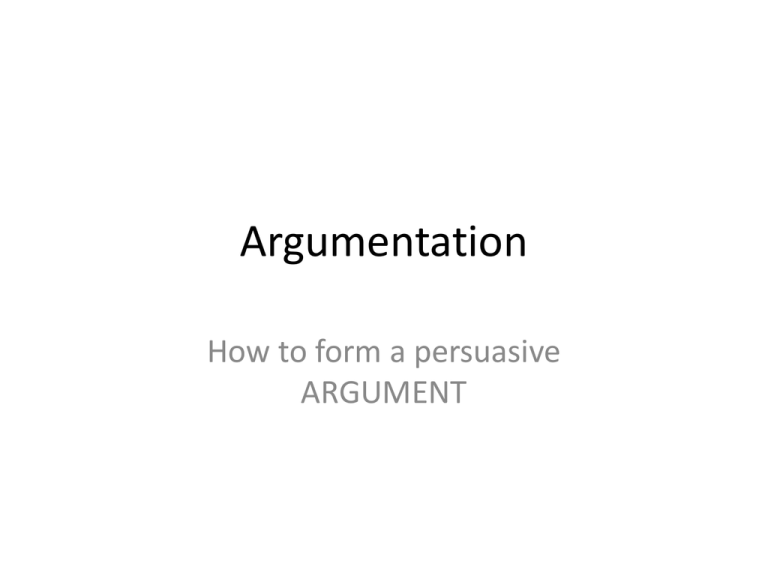
Argumentation How to form a persuasive ARGUMENT What do we believe in, and why? • “I can’t believe the news today. I can’t close my eyes and make it go away.” • Bono • Cite examples of events in the news that you would like to be able to help, change, fix, or in general make better. • Discuss why people cannot “close [their] eyes and make it go away.” • Do our beliefs reflect the way we analyze and react to information? Why Persuasion? • Authors are trying to convince you to believe or act a certain way. • Audiences are most likely to agree with writers whose ideas seem credible and whose evidence seems valid. • Structure and tone of an argument also influence how you act. Writer’s Intent • The intent is to convince you to think or act a certain way. • It might be to change the way you think, call you to action, or ask you to go out and do something. • Intent is communicated either objectively or subjectively. Objective vs. Subjective • Objective uses provable facts. (strongest approach) • Subjective focuses on a writer’s experiences, feelings, and opinions. • Sometimes writers will use both. Credibility and Evidence • How credible or believable is an author? • Credibility depends on qualifications and quality of evidence presented • Qualifications might include expert status or experience in the topic under discussion. Evidence • Evaluate the person’s argument carefully. Make sure it is supported through evidence or proof! (“Because I said so” is not proof!) • Logical Appeals: facts, statistics, and examples to speak to a reader’s reason and common sense. • Emotional appeals: speak to a reader’s emotions (e.g. fear, sympathy, anger) – May include loaded words (strong connotations) or anecdotes (personal accounts of an event). Analyze the Credibility of an Argument Yes Is the author’s intent clear? Is the author qualified to write about this subject? Is the author unfairly biased or prejudiced regarding this subject? Does the author use enough logical or objective evidence? No Structure/Organization • A good argument should be organized carefully and logically. • May be organized by cause/effect, problem/solution, chronological order, or question/answer. • Readers generally remember the most about the beginning and end of a piece. Many arguments are structured so it moves from the least important to most important or from a general idea to a specific call to action. Try this… • What organizational structure does Martin Luther King, Jr. use to begin his speech to the First Montgomery Improvement Association? – “We are here in a general sense because first and foremost we are American citizens, and we are determined to apply our citizenship to the fullness of its meaning.” • From “There Comes a Time When People get Tired” by Dr. Martin Luther King, Jr. Answer • Starts with general ideas and ends with a specific call to action. – “We are here in a general sense because first and foremost we are American citizens, and we are determined to apply our citizenship to the fullness of its meaning.” • From “There Comes a Time When People get Tired” by Dr. Martin Luther King, Jr. Tone • A writer’s tone reflects his or her attitude toward the subject or audience and is closely related to intent. • Identifying the tone of a text can help you evaluate the credibility of an argument. For example, if a writer uses a highly emotional tone for an argument that is meant to be objective, the argument might lack evidence and credibility. Compare the two TONES • “The countryside was, in fact, famous for the abundance and variety of its bird life, and when the flood of migrants was pouring through in spring and fall people traveled from great distances to observe them.” • Rachel Carson, Silent Spring • What a treat it was not to strike terror into the hearts of other living things! I could spend hours regarding rubbery black marine iguanas sunning in sloppy, chummy piles like discarded dime-store dinosaurs; instead of bolting, they simply grinned and dozed.” • Judith Stone “Kiss and Tell” Two Tones Compared • Rachel Carson creates a serious tone with formal sentence structure and word choice. How does it affect your perception of the reading? • Judith Stone creates an informal, yet sincere, tone through lighthearted language and imagery. Now rewrite the excerpts from Silent Spring and “Kiss and Tell,” using word choice to change the tone of the passage. A few volunteers will read your revised passages to the class. The class will identify the tone of each revised passage and support your assessment with references to word choice. Analyze Argumentation • “For those of you who are black and are tempted to be filled with hatred and distrust at the injustice of such an act, against all white people, I can only say that I feel in my own heart the same kind of feeling. I had a member of my family killed, but he was killed by a white man.” – From “Eulogy for Martin Luther King, Jr.,” by Robert F. Kennedy 1. What is the speaker’s intent? 2. What is the tone of this passage? 3. Is the author appealing to logic or emotion, or both? Explain. With a Partner: Define the following words from our notes today – Objective – Subjective – Evidence – Logical – Emotional – Connotations – Anecdotes Definitions: • Factual, like an object • Based on the speaker’s or subject’s thoughts and opinions • What is evident or can be seen or understood • Appeals to the brain • Appeals to feelings • Feelings, thoughts, or ideas associated with words • Personal stories

